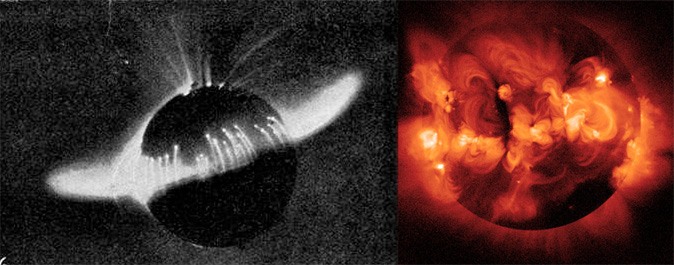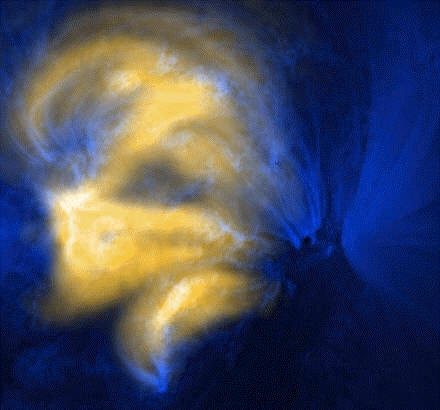From Birkeland, just to give the readers a background:
Birkeland said:
It is by powerful magnetisation of the magnetisable globe that the phenomenon answering to Saturn's rings is produced. During this process, polar radiation and disruptive discharges at the equator such as that shown in fig. 247a (which happens to be a unipolar discharge) [this is MM's picture of the "loops"] may also occur, if the current intensity of discharge is great. If the magnetisation of the globe be reduced (or the tension of the discharge increased) gradually, the luminous ring round the globe will be reduced to a minimum size, after which another equatorial ring is developed and expands rapidly (Fig 247 b).
So Birkeland was trying to model Saturn in this picture. For those who do not know what a "unipolar discharge" is, the following:
Ye and Zheng said:
from here
Discharge in a fine tube is a simple way of generating a dielectric barrier discharge microplasma jet under atmospheric pressure (AP). Since its electrodes are directly connected by a dielectric, discharge behaviour in this kind of tubular-electrode plasma could be significantly different from that of a parallel-plate plasma source having planar electrodes.
Which is a breakdown of the dielectric, like in a plasma ball. And to advance a bit on that, inside a plasma ball
there is no plasma (unlike you would think from the name). The only plasma in that ball is
in the discharges from the central ball to the glass sphere.
Now, there is no dielectric in the Sun, it is a plasma, so the idea that there would be discharges is interesting, but basically impossible.
I love how you claim something is "impossible' when it's already been physically recreated in a lab over 100 years ago. It's not "impossible" as you can see from the image I cited.
Because Birkeland's experiment, although very interesting to create the aurora, does not well describe the physics of the Sun nor does it describe well the physics of Saturn's rings. Therefore, it is impossible.
If you mean "induction", sure it plays a role in the "flinging' of plasma. If you're talking about 'magnetic reconnection', forgetaboutit. Only circuits and particles are physically capable of "reconnecting". Magnetic lines form as a whole and complete continuum, without beginning and without end, and *without* reconnecting to any other magnetic lines.
Induction
cannot replace magnetic reconnection, you cannot change the topology of the magnetic field using only induction.
The plasma in the plasma ball on my desk is a "light" and very dusty plasma. I can see the light from a single candle through a foot of it as though it's not even there. I'm sure I'd see my arc welder through it too.

The gas in a plasma ball is not plasma, only when a discharge takes place does the gas get ionized.
The *DENSITY* does however matter, and you're claiming that the density at the surface of the photosphere is very thin. Your "opacity" numbers are based upon a *NON* mass separated "assumption".
Does it assume all the elements stay mixed together at the surface of the photosphere?
Which photons? All of them? The photons from the loops? The photons seen in 1600A? They all come from the photosphere in your opinion?
"Last scattering"? For *EVERY SINGLE* wavelength? Surely not every wavelength will operate the same way?
Apparently, you have no knowledge about radiative transport in plasmas. Too bad, because it is highly important. Naturally I do not mean "at all wavelengths" if you would have read carefully, you would have seen that I wrote that "he optical depth of the plasma, it can either be transparent or opaque, and that depends
on wavelength, density and length of the plasma column." That is why the photoshpere is not just a flat surface it is a layer with a certain thickness.
And naturally I do not say that the photons from the coronal loops come from the photosphere, the idea is ludicrous. These emissions are "superposed" onto the radiation that is coming from the photosphere.
I love how you say it "will-be" in such a casual manner as though this is already certain. It's not. It's certainly going to be wavelength dependent and not every wavelength can or would be absorbed at the same rate. Even scuba diving taught me that light does not get absorbed at the same rate. Red light does not penetrate as deeply as blue light, or yellow light.
Have you frakking READ what I wrote!?!?!?!?! I specifically wrote, like any other (plasma)(astro)physicist would do that the optical depth is
WAVELENGTH DEPENDENT.
How does that compare to say the plasma in an ordinary plasma ball?
Plasma balls are irrelevant, because they have no plasma.
The photosphere is a double layer of neon. The white light above the photosphere comes from the arcs. The white light along the bases of the loops is brightly lit on both sides, just as a birkeland solar model predicts.
And what kind of double layer would that be, a current carrying DL, or a boundary DL, and what is causing it to be a DL and what is the electric field, and why would the photosphere be made out of neon?
And again, hone your writing skills "the white light along the bases is of the loops is
brightly lit on both sides?" how can light be lit? Sounds really profound MM, until you read what is really written.
His math relates to the flow of both positively and negatively charged particles. What did you get from that math?
I went through the math (
see my message on page 12) and there was NOTHING I could find on this process. The motion of charged particles near a gravitating magnetized sphere, no solar wind there, please, if I am mistaken, show me where exactly Birkeland explains the process that YOU are promoting.
In other words, observational evidence be damned. You don't even care to see it. Why would you? It blows your whole show.
Oh, boy are you childish! Don't you forget ever anything to take home from work. The number of times I forget my cell phone on my desk .......
But then observations of flares are not what you would call "controlled experiments" so why would we believe any results coming from them.
I can easily see "flying stuff" and real objects in RD images, and I can see mass movements at the bases of the arcs all along the transitional region. I guess I'm more of any "expert" than the rest of you as it relates to solar physics and satellite image analysis. You can't even see the flying stuff evidently without someone holding your hand for a week. The fact you guys let GM get away with claiming the persistence has anything to do with the RD technique says volumes.
In those images you will see that the arcs come up through the surface of the photosphere, they light up the surface of the photosphere on both sides of the arcs, and blow plasma from the surface of the photosphere up and into the chromosphere. All of that is consistent with the discharge occurring *UNDER AND THROUGH* the photosphere, not high above it. Why is the plasma moving upwards rather than downwards if the primary "blast" is high above the photosphere?
the plasma filling the magnetic loop is also very consistent with just the shear motion of the foot points, generating an electric field along the field lines and a current/plasma flow is set up. This is not what one call a discharge, because there is no break down of any dielectric which refrained the "charge separation" to equalize.
No, I don't toss away any observations. They are the key to validating and falsifying any and all solar models. By your logic, the "flare" should have originate above the photosphere, it has no particular reason to light up the surface of the photosphere at the bases of the arcs, and plasma at the surface of the photosphere would be likely to be blow *DOWNWARD* from the blast above, not upwards and into the chromosphere. The physics doesn't work in your favor.
But they are not controlled experiments, MM!
You have totally no idea about solar flares theory, do you? In
all models of solar flares
it is expected that
the footpoints brighten. And no, the plasma would not be "blasted downward" because in those magnetic loops the plasma is magnetized.
How do I verify your claim?
So let's see an iron sphere in the sun. How big?
How does it stay stable?
How much uranium is creating all that heat and current?
How does fission of uranium create a current anyway?
How do I verify your claims?
I agree. It can only tell us what is underneath of the photosphere in mathematical terms. There's another example of a bunch more math that you folks simply ignore.
That is not what I said, MM, I said that you can use helioseismology to determine what the photosphere is made of,
one of your claims to which I replied, and now you try to twist it around in such a way that helioseismologist don't know squat. You are so frakking insincere in the way you discuss. Can you back up your claim that
anything is ignored?
I'm aware of the definitions. I'm also aware of the fact that they are gross oversimplifications and just plain wrong. Sure, the photosphere emits the most *VISIBLE* light. That is primarily due to it's elemental composition (neon).
And why exactly should it be made of neon, why not of helium, which is the "solar particle".
I'm just so used to getting pathetic answers at this point, and it's hard to believe you've really seen this stuff, or it wouldn't be something you take so lightly as to not bother looking at it or explaining it before commenting on it.
I doubt you are correct because he already simulated a "glowing' plasma atmosphere.
He could certainly see below his glowing plasma around the sphere to describe the origin of the loops and their relationship to physical bumps on the sphere. Evidently you think he was some sort of simpleton.
Na, that was evidently Galileo that did that.

More Birkeland blah blah about things he never even heard of.
Lot's of peeps are working on solar flares in lots of different wavelengths for observations. Once more, you are not the sole person in the world who watches soho movies and you are certainly no expert on solar flares.


